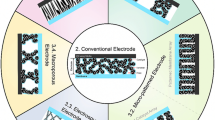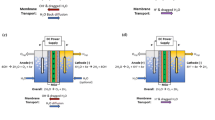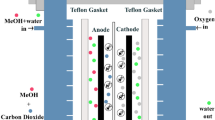Abstract
A novel proton-exchange polymer composite membrane was synthesized using Nafion®, tetraethoxysilane-modified carbon nanotubes (CNTs) and phosphotungstic acid-modified carbon nanotubes with the aim of using direct methanol fuel cells (DMFCs). Physicochemical properties of the modified CNTs and fabricated composite membranes were investigated by Fourier transform infrared spectroscopy, field emission scanning electron microscopy, water uptake, thermogravimetric analysis, ion exchange capacity, proton conductivity and methanol permeability tests. It was demonstrated that chemical surface modification of CNTs and introduction of the phosphotungstic acid (PWA) groups effectively improved the performance of DMFC. It was found that the presence of PWA groups on the surface of CNTs led to the formation of strong electrostatic interactions between the PWA groups and clusters of sulfonic acid in Nafion® macromolecules. Hence, the incorporation of inorganic phosphotungstic super-acid-doped silicon oxide-covered carbon nanotubes (CNT@SiO2-PWA) into Nafion® matrices enhanced the proton conductivity of the prepared membranes. Moreover, the methanol permeability was reduced to 2.63 × 10−7 cm2 s−1 in comparison with the recast Nafion® membrane (2.25 × 10−6 cm2 s−1). Enhancing the proton conductivity and reducing the methanol permeability, the selectivity of the prepared nanocomposite membranes was enhanced to a greater value of 330,700 S s cm−3 as compared to the value of 38,222 S s cm−3 for recast Nafion®.







Similar content being viewed by others
References
Hacquard A (2005) Improving and understanding direct methanol fuel cell (DMFC) performance. MS Thesis Worcester Polytechnic Institute
Awang N, Ismail AF, Jaafar J, Matsuura T, Junoh H, Othman MHD, Rahman MA (2015) Functionalization of polymeric materials as a high performance membrane for direct methanol fuel cell: a review. React Func Polym 86:248–258
Liu L, Chen W, Li Y (2016) An overview of the proton conductivity of nafion membranes through a statistical analysis. J Memb Sci 504:1–9
Mauritz KA, Moore RB (2004) State of understanding of Nafion. Chem Rev 104:4535–4586
Schmidt-Rohr K, Chen Q (2008) Parallel cylindrical water nanochannels in Nafion fuel-cell membranes. Nat Mater 7:75–83
Yin Y, Li Z, Yang X, Cao L, Wang C, Zhang B, Wu H, Jiang Z (2016) Enhanced proton conductivity of Nafion composite membrane by incorporating phosphoric acid-loaded covalent organic framework. J Power Sources 332:265–273
Hasani-Sadrabadi MM, Emami SH, Ghaffarian R, Moaddel H (2008) Nanocomposite membranes made from sulfonated poly (ether ether ketone) and montmorillonite clay for fuel cell applications. Energy Fuels 22:2539–2542
Hasani-Sadrabadi MM, Mokarram N, Azami M, Dashtimoghadam E, Majedi FS, Jacob KI (2011) Preparation and characterization of nanocomposite polyelectrolyte membranes based on Nafion® ionomer and nanocrystalline hydroxyapatite. Polymer 52:1286–1296
Parthiban V, Akula S, Sahu AK (2017) Surfactant templated nanoporous carbon-Nafion hybrid membranes for direct methanol fuel cells with reduced methanol crossover. J Membr Sci 541:127–136
Bose S, Kuila T, Nguyen TXH, Kim NH, Lau KT, Lee JH (2011) Polymer membranes for high temperature proton exchange membrane fuel cell: recent advances and challenges. Prog Polym Sci 36:813–843
Hasanabadi N, Ghaffarian SR, Hasani-Sadrabadi MM (2013) Nafion-based magnetically aligned nanocomposite proton exchange membranes for direct methanol fuel cells. Solid State Ionics 232:58–67
Li J, Park JK, Moore RB, Madsen LA (2011) Linear coupling of alignment with transport in a polymer electrolyte membrane. Nat Mater 10:507–511
Alvarez A, Guzman C, Carbone A, Sacca A, Gatto I, Passalacqua E, Nava R, Ornelas R, Ledesma-Garcia J, Arriaga L (2011) Influence of silica morphology in composite Nafion membranes properties. Int JHydrogen Energy 36:14725–14733
Hu D, Xing Y, Chen M, Gu B, Sun B, Li Q (2017) Ultrastrong and excellent dynamic mechanical properties of carbon nanotube composites. Compos Sci Technol 141:137–144
Adamska M, Narkiewicz U (2017) Fluorination of carbon nanotubes—a review. J Fluorine Chem 200:179–189
Asgari MS, Nikazar M, Molla-abbasi P, Hasani-Sadrabadi MM (2013) Nafion®/histidine functionalized carbon nanotube: high-performance fuel cell membranes. Int J Hydrog Energy 38:5894–5902
Lee JW, Khan SB, Akhtar K, Kim KI, Yoo TW, Seo KW, Han H, Asiri A (2012) Fabrication of composite membrane based on silicotungstic heteropolyacid doped polybenzimidazole for high temperature PEMFC. Int J Electrochem Sci 7:6276–6288
Kozhevnikov I (2009) Sustainable heterogeneous acid catalysis by heteropoly acids, vol II: handbook of green chemistry, heterogeneous catalysis. Wiley-VCH, Weinheim
Huang T, Tian N, Wu Q, Yan Y, Yan W (2015) Synthesis, crystal structure and conductive mechanism of solid high-proton conductor tungstovanadosilicic heteropoly acid. Mater Chem Phys 165:34–38
Jalani NH, Dunn K, Datta R (2005) Synthesis and characterization of Nafion®-MO2 (M = Zr, Si, Ti) nanocomposite membranes for higher temperature PEM fuel cells. Electrochim Acta 51:553–560
Sakamoto M, Nohara S, Miyatake K, Uchida M, Watanabe M, Uchida H (2014) Effects of incorporation of SiO2 nanoparticles into sulfonated polyimide electrolyte membranes on fuel cell performance under low humidity conditions. Electrochim Acta 137:213–218
Staiti P, Arico A, Baglio V, Lufrano F, Passalacqua E, Antonucci V (2001) Hybrid Nafion–silica membranes doped with heteropolyacids for application in direct methanol fuel cells. Solid State Ionics 145:101–107
Rosca ID, Watari F, Uo M, Akasaka T (2005) Oxidation of multiwalled carbon nanotubes by nitric acid. Carbon 43:3124–3131
Stöber W, Fink A, Bohn E (1968) Controlled growth of monodisperse silica spheres in the micron size range. J Colloid Interface Sci 26:62–69
Rafiee E, Eavani S, Malaekeh-Nikouei B (2012) 12-Tungstophosphoric acid immobilized on γ-Fe 2 O 3@ SiO2core–shell nanoparticles: an effective solid acid catalyst for the synthesis of Indole derivatives in water. Chem Lett 41:438–440
Li H, Ha CS, Kim I (2009) Fabrication of carbon nanotube/SiO2 and carbon nanotube/SiO2/Ag nanoparticles hybrids by using plasma treatment. Nanoscale Res Lett 4:1384
Vinayan B, Nagar R, Raman V, Rajalakshmi N, Dhathathreyan K, Ramaprabhu S (2012) Synthesis of graphene-multiwalled carbon nanotubes hybrid nanostructure by strengthened electrostatic interaction and its lithium ion battery application. J Mater Chem 22:9949–9956
Bardin BB, Bordawekar SV, Neurock M, Davis RJ (1998) Acidity of Keggin-type heteropolycompounds evaluated by catalytic probe reactions, sorption microcalorimetry, and density functional quantum chemical calculations. J Phys Chem B 102:10817–10825
Aparicio M, Castro Y, Durán A (2005) Synthesis and characterisation of proton conducting styrene-co-methacrylate–silica sol–gel membranes containing tungstophosphoric acid. Solid State Ionics 176:333–340
Rocchiccioli-Deltcheff C, Fournier M, Franck R, Thouvenot R (1983) Vibrational investigations of polyoxometalates. 2. Evidence for anion-anion interactions in molybdenum (VI) and tungsten (VI) compounds related to the Keggin structure. Inorg Chem 22:207–216
Watson JM, Zhang GS, Payne PA (1992) The diffusion mechanism in silicone rubber. J Memb Sci 73:55–71
Thomassin JM, Kollar J, Caldarella G, Germain A, Jérôme R, Detrembleur C (2007) Beneficial effect of carbon nanotubes on the performances of Nafion membranes in fuel cell applications. J Membr Sci 303:252–257
Molla-Abbasi P, Asgari MS, Hassani Sadrabadi MM (2017) Improving the performance of Nafion®-based fuel cell membranes by introducing histidine functionalized carbon nanotubes. J Macromol Sci B 56:234–244
Rodgers MP, Shi Z, Holdcroft S (2008) Transport properties of composite membranes containing silicon dioxide and Nafion®. J Membr Sci 325:346–356
Choi BG, Hong J, Park YC, Jung DH, Hong WH, Hammond PT, Park H (2011) Innovative polymer nanocomposite electrolytes: nanoscale manipulation of ion channels by functionalized graphenes. ACS Nano 5:5167–5174
Zhong S, Cui X, Dou S, Luo Y, Cui W, Zhao S, Zhu H, Liu W (2010) Silicon-containing sulfonated polystyrene/acrylate–phosphotungstic acid hybrid membranes with high methanol barrier and good proton conductivity. Solid State Ionics 181:1499–1504
Qiao J, Hamaya T, Okada T (2005) New highly proton-conducting membrane poly (vinylpyrrolidone)(PVP) modified poly (vinyl alcohol)/2-acrylamido-2-methyl-1-propanesulfonic acid (PVA–PAMPS) for low temperature direct methanol fuel cells (DMFCs). Polymer 46:10809–10816
Choi P, Jalani NH, Datta R (2005) Thermodynamics and proton transport in Nafion II. proton diffusion mechanisms and conductivity. J Electrochem Soc 152:E123–E130
Hasani-Sadrabadi MM, Dashtimoghadam E, Majedi FS, Moaddel H, Bertsch A, Renaud P (2013) Superacid-doped polybenzimidazole-decorated carbon nanotubes: a novel high-performance proton exchange nanocomposite membrane. Nanoscale 5:11710–11717
Sung KA, Oh KH, Kim WK, Choo MJ, Nam KW, Park JK (2011) Proton exchange membrane using imidazole-functionalized silica to enhance proton conductivity at lower humidity. Electrochem Solid State Lett 14:B114–B116
Author information
Authors and Affiliations
Corresponding author
Rights and permissions
About this article
Cite this article
Molla-Abbasi, P., Janghorban, K. & Asgari, M.S. A novel heteropolyacid-doped carbon nanotubes/Nafion nanocomposite membrane for high performance proton-exchange methanol fuel cell applications. Iran Polym J 27, 77–86 (2018). https://doi.org/10.1007/s13726-017-0587-0
Received:
Accepted:
Published:
Issue Date:
DOI: https://doi.org/10.1007/s13726-017-0587-0




